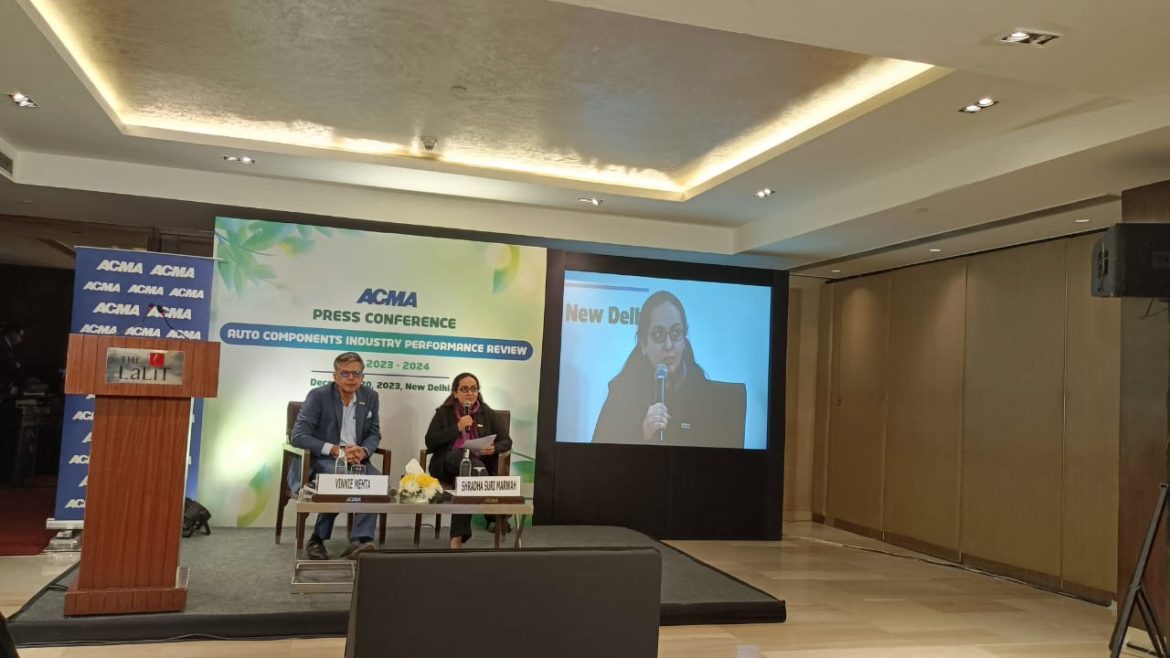The Indian auto component manufacturing industry has grown by 12.6% in the first half of the ongoing fiscal year FY24, the apex body representing the industry – Automotive Component Manufacturers Association of India (ACMA) – announced on Wednesday. The turnover of the industry stood at INR 2.98 lakh crore (USD 36.1 billion) for the period April to September 2023 led by growth in sales to OEMs and increase in exports. The turnover for the corresponding period a year ago stood at 2.65 lakh crore (USD 33.9 billion).
Drive transmissions and steering components made up a lion’s share in the sales pie – 34%, followed by engine components at 20%. Components such as electricals and electronics, suspension and braking, and body/chassis contributed 11% each.
Sharing insights on the steadfast growth in the industry, ACMA President Shradha Suri Marwah, said that vehicle sales across all segments have reached pre-pandemic levels thanks to mitigation of supply-side issues, better availability of semiconductors and growing demand for passenger vehicles. “The auto components sector witnessed a steady growth in both domestic and the international markets in the first-half of FY2023-24,” she added.
PV components made for 46% in sales to OEMs
In the domestic market, the turnover of the auto component industry stood at INR 2.54 lakh crores (USD 30.8 billion) for H1FY24, growing 13.9% compared to the first half of the previous year. The growth was buoyed by increase in consumption of value-added components and the shift in market preference towards larger and more powerful vehicles. The passenger vehicle segment contributed 46% in sales to OEMs, followed by two-wheelers at 19%, and light commercial vehicles at 16%.
Exports grew by 2.7%
The turnover from exports of auto components in the first half of FY24 stood at INR 85,870 crore (USD 10.4 billion) as compared to INR 79,033 crore (USD 10.1 billion) in H1 FY23. USA remained the single largest export destination with North America accounting for 33% sales while Latin America adding up another 5%. Europe too accounted for another 33%, witnessing an increase of 12% over last fiscal year. Though there has been a steadfast growth in exports to these regions, ACMA remained cautious in its outlook given the economic slowdown in European markets due to the ongoing Russia-Ukraine war. Though mild, the recession trend in the US also affected the outlook.
Asia accounted for 24% of exports, witnessing a decline of 4%. Exports to South Asian nations like Bangladesh, Nepal, and Sri Lanka declined due to muted economic activity in the region.
Imports grew by 3.6%
The Indian auto component industry spent INR 87,425 crore (USD 10.6 billion) on imports in H1 FY24 as compared to INR 79,815 crore (USD 10.2 billion) in FY23. China remained the single largest import destination at 28%, followed by Germany at 12%, South Korea at 10% and Japan at 9%. Region-wise, Asia accounted for 63% of imports, followed by Europe and North America, with 27% and 9%, respectively. Imports from Asia grew by 2%, from Europe by 8%, and from North America by 2.5%.
Focus on localization
While growth in imports outdid the growth in exports in H1FY24, ACMA is confident that localization will play a key role in reducing imports. “With shift in consumer preference towards connected, high-end vehicles, new regulatory changes, newer technologies, and increased market demand, it is inevitable that imports will grow. Localisation cannot happen so quickly. However, there is huge impetus on localisation and the government policies are supporting that,” said Vinnie Mehta, Director General, ACMA. Adding to this, Shardha said, “As scale comes up, there will be an increase in capital outlay, and localisation will happen with scale.”
India has majorly imported engine components and body/chassis in the said period, forming 32% and 18% of the imports pie, respectively. While government policies are favouring Indian-made products, imports are needed to absorb newer technologies.



